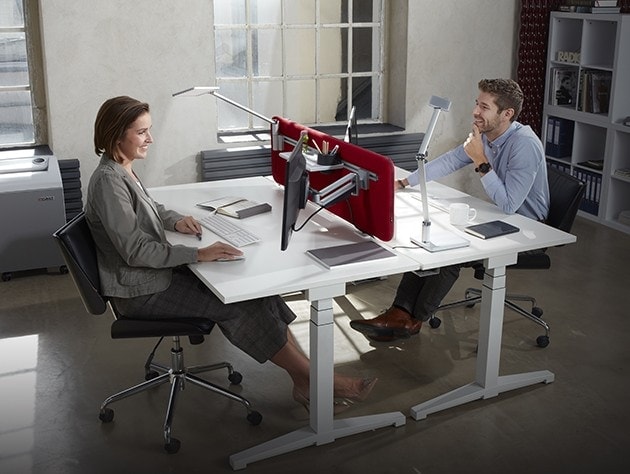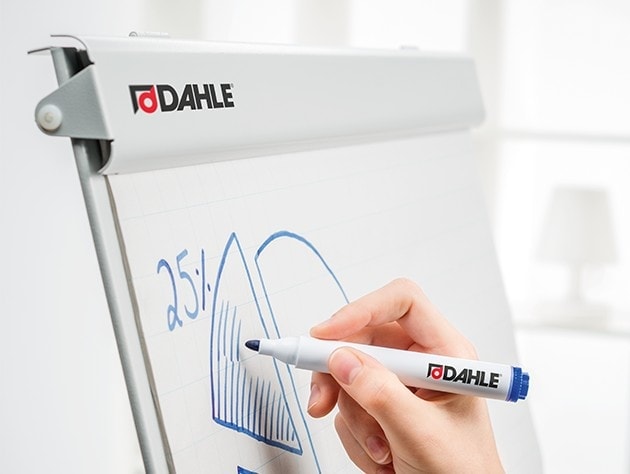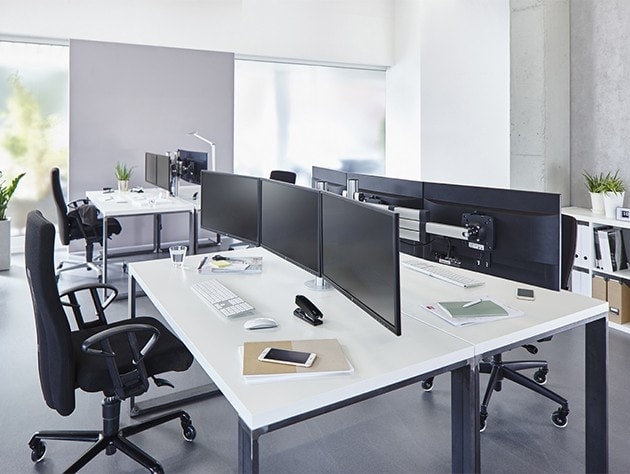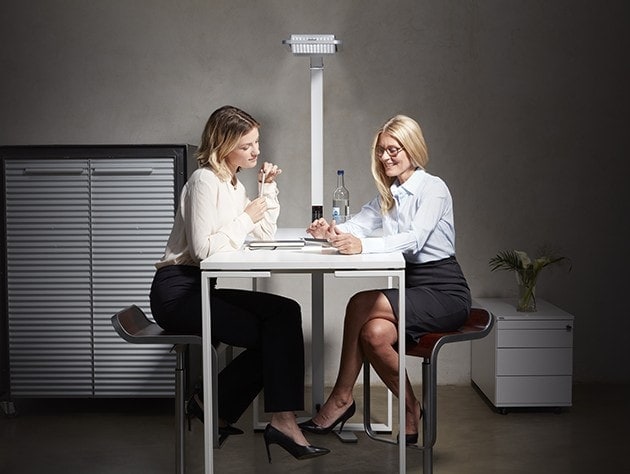Noisy, hectic and stressful – many people associate open-plan offices with a call-centre atmosphere. But the Open Space office is a rather different concept from an open-plan office and has little in common with those well-known, crowded seas of desks. Instead of creating a lot of identical workplaces, workspaces are divided into different functional areas. Everything is possible, from spaces for individual work and group work, to room for telephone calls and break-out areas. Some companies even do away completely with fixed desks for their employees. This means that staff can use any work area and vary their position at will – thanks to laptops, mobile phones and the like!
Open Space offices should stimulate communication between workers and encourage creativity and productivity. And Open Space offices are becoming more and more popular. Google and Microsoft are setting the example for us. They swear by this office concept and show that it works in practice. But Open Space offices are not only suitable for huge corporations. We will show you how you can set one up yourself and what benefits you can gain from it.

The origin of Open Space
Open Space Technology (OST) is a method of organising and moderating large groups of 20 to 2000 participants at conferences. The aim is to work together on a theme and its sub-themes in a solution-oriented and innovative way. Participants can submit their own ideas, which will be further developed collectively by smaller groups. The focus here is on self-organisationand self-responsibility. Open Space offices are intended to promote the same method of open communication and self-organized work in open office spaces.

How an Open Space conference works
The open working atmosphere in an Open Space office is intended to promote communication and ensure that problems are solved more quickly. In the office, a simplified version of the OST method can be transferred to work meetings and brainstorming sessions.
- All the participants start by sitting in a circle. A round of introductions follows, and the moderator explains the goals, limits and resources.
- This is followed by an introduction to a topic to be handled. Which of the topic’s aspects are handled depends on the participants’ concerns. Anyone can introduce a concern about the topic that they want to work on. Concerns are topics that are particularly important to a person and for which someone wants to take responsibility.
- Times and workspaces are assigned to each concern on a brown-paper wall or a flipchart.
- Every participant can then assign themselves topics.
- The group work phase is self-organised. Ideas are developed and documented.
- The results of all the groups are displayed on a documentation wall for everyone to see.
- The results are then evaluated, and their further implementation planned.
How can an office be upgraded to Open Space?
Open Space offices are large spaces that are individually tailored to the needs of the company and its employees – 20 identically arranged workspaces in separate offices are a thing of the past. People who want to concentrate on their work can withdraw to areas with individual workspaces. People who want to work in a group or have a meeting appointment, on the other hand, can find suitable group workspaces or conference rooms. There are also dedicated spaces for telephoning or break-out areas.

Implementation tips for Open Space offices:
An Open Space office is characterised by various work areas that employees can freely choose from. There are several options for these:
An office for focused solo work at a PC
This requires flexible desks, chairs and additional accessories of your choice. Mobile devices such as laptops, tablets and flexible monitor mounts make it easier to work with multiple monitors. Adjustable mounts are particularly useful in ensuring workplaces are ergonomic. LiftTEC from Novus makes it very easy. You can move the monitor right or left, up or down. Or just move it further away when you don’t need it. In addition, the integrated ball-and-socket joint allows the monitor to be tilted and rotated flexibly. Find out more about the advantages of Novus LiftTEC.

An office for group work and customer meetings
An office for group work and customer meetings has a large table, around which you can sit with your colleagues or customers. For brainstorming sessions and presentations, the room should also have presentation technology such as flipcharts or whiteboards. A projector and a screen are also useful. Since the room is intended for exchanging information, talks and round-table discussions can take place here.
A space with different working and privacy options
If ergonomics and privacy are important to you, you can equip a room with bar tables and separate lounge areas. This will allow people to change positions – which is good for your health, as it prevents back and neck pain. In the lounge area you can relax as you work and talk quietly with your colleagues about your projects.
A room for telephoning, printing and shredding documents
Printers are an annoying source of noise, and telephone calls quickly catch the attention of all the staff – making them the number-one source of distraction. You can avoid this by setting up a separate room for printing and document shredders, as well as a separate room for phone calls or telephone conferences.
A shared meeting point is particularly useful for group dynamics. Here you can meet up to eat together or talk about personal issues. If you don’t have a separate kitchen, there is at least a coffee machine, and maybe a kettle, a fridge and a microwave in this room. To make the area inviting and encourage people to spend time there together, you are free to decorate it as you like – with plants and pictures of all your colleagues, for instance. And, very importantly, to create a truly open and inviting atmosphere in your Open Space office, no one will shut themselves away behind closed doors any more. With the exception, of course, of noisy group meetings and customer appointments that would disturb your colleagues.
What is essential in an Open Space office?
Some employees are extroverted, others are introverted. Extroverts usually don’t have a problems with higher volumes, while introverted workers can no longer concentrate at all in such conditions. To ensure an Open Space office is comfortable for everyone, you need to establish some clear rules. The following points may help you as a guide:
- People with loud voices should dial it down a little when on the phone
- Team meetings and group work should take place in the designated rooms
- Headphones can be used to show that you don’t want to be disturbed
Advantages of an Open Space office
Open Space offices offer some advantages for your company and for yourself. We have collected a few for you – you can use them to convince any sceptical bosses of the merits of Open Space offices.
Short communication channels
From the team leader to the intern, everyone sits in the same room. So, if you need help or want to exchange ideas, there’s always someone nearby. This means problems can be solved, and decisions made, quickly and efficiently.
Group dynamics
The group dynamics and relationships with your colleagues automatically improve in the Open Space office, because you can communicate with each other much better and more often – formally and informally.
Information flow
In contrast to individual offices, most information in the Open Space office is openly accessible to you. So you don’t have to wait for internal notifications, but are always up-to-date.
Lower costs
An Open Space office usually takes up less office space than the same amount of workspaces would require with individual offices. This usually means less office rent and lower energy costs – every boss should be pleased about that.
Flexibility
Flexibility is working at a regular desk or a standing desk, as you prefer. This can inspire creativity, but that’s not the only advantage: changing your posture from time to time will improve your health, too. An Open Space office can have a positive effect on you and your way of working in many areas. We wish you a lot of fun and great success in your Open Space office! Disadvantages of open offices Whether an open-plan office really makes sense depends on the type of company. Although open-plan offices are being used more and more, they are not necessarily popular with employees. According to a Harvard study, in fact, open-plan offices can have the opposite effect. Instead of promoting communication, the open atmosphere actually inhibits it. Scientists Ethan Bernstein and Stephen Turban discovered in their two-week observation phase that employees used other means of communication such as private messengers or emails instead of talking directly to each other. Before committing, companies should think carefully about whether an open office culture fits the way they work and the field they work in.
